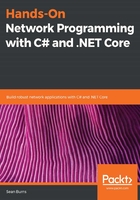
Physical and logical topologies
In the same way that the topology of a geographic region describes how the features of that region are arranged over the area of the region, the topology of a network describes how the components of that network are arranged relative to one another. There are two ways to think about the organization of networks. As should be obvious, having read the header for this subsection, they are the physical topology and the logical topology.
The physical topology describes how a network is physically connected and organized in real space. It describes the medium by which connections are established, the medium of the connections themselves, the location of devices in physical space, and the layout of the connections between nodes. It is determined, in part, by the specific networking devices of the network and the connections those devices allow (I can't use coaxial cabling to connect to a router with only Ethernet ports). Separately, the physical topology itself determines the maximum capabilities of the network in terms of performance, resilience, and, in some cases, even security. Imagine that all incoming network traffic trying to access a local area network (LAN) I own must be funneled through a firewall for security purposes. If I only expose one physical device to act as that firewall, my network won't be very fault tolerant. However, if I expose multiple firewall devices, with each servicing requests from different regions, I can increase my fault tolerance considerably. Especially if each is capable of serving as a backup in the event that one of the others is taken offline for any reason. The physical topology of one firewall provides less fault tolerance than the physical topology of several.
The physical topology also describes the variety of network devices I use on the network at any point in time. This is where our high-level abstractions of communication channel and node or computational device is brought down into concretions. Instead of a link or connection, a physical topology characterizes a connection as wired or wireless. A robust topology may even specify the type of wire used as coaxial or fiber optic cables, as is typical of most high-speed home internet connections, or as twisted-pair copper wire, like what's used for telecom networks.
This is also where our network nodes get nailed down to a concrete, specific device. Instead of a computational device, we have switches, routers, bridges, and network-interface controllers (NIC). Each of these devices is responsible for a different task or service on a network, and some, or all, of them may be present on any given implementation. For example, I have no need for a bridge on my home wireless network, but it would be impossible to imagine how the entire internet could exist without the use of each and every device I listed, and dozens more that I haven't.
Meanwhile, the logical topology of a network explains the conceptual organization of relevant actors on the network, and the connective paths over which they can, or must, communicate with any other actors on that network. One important consideration to make, though, is that physical topologies do not necessarily map directly to the logical topology. Looking back at our earlier example of a physical topology with one firewall as compared to a physical topology of multiple firewalls, we can illustrate the distinction between physical and logical. First, let's take a look at the initial, naive implementation of an internal network with a single physical firewall device to restrict access to our server resources:

While a complete physical topology would define and describe the type of connection supported, and perhaps even define the model of the physical devices represented in the preceding diagram, this will be sufficient for our purposes. Next, let's look at the more resilient physical topology with multiple firewalls and a failover strategy for unresponsive firewalls:

It's easy to see why the physical topology diagram would be different, because there are different physical components in play. What's more, for as simple a difference as it is between them, the physical difference between the two is non-trivial, as the second topology has a meaningful impact on the owner of the network in terms of cost, reliability, and performance.
The point we want to make with this, however, is that in both physical implementations, the logical topology remains the same. If we think of the single firewall (in the case of the first physical topology) and the multi-firewall along with requesting the brokering router (in the case of the second physical topology) as being, conceptually, a single secure access point into our internal network, then we can easily see how both physical topologies map to the following logical topology:

Looking at this diagram, you might also notice that it bears a striking resemblance to the physical layout of the first diagram, but looks wholly different from the second. This serves to illustrate the fact that a logical topology might map one-to-one to its physical counterpart, but does not necessarily map one-to-one with its physical implementation.
For the remainder of this book, we'll exclusively be concerned with the logical topology of a network, as this abstraction defines the interactions we'll be processing in the software we build. Device manufacturers can deal with the hardware components, and network engineers can work to meet the physical performance constraints. We'll just think about what resources we need, or need to provide, and how we can meet those needs. The logical topology will be sufficient for that.
The specific organization of the logical topology of our network may well have an impact on our software implementation, however, and there is a variety of common topologies with their own strengths and disadvantages we'll want to consider, so we should take some time to do so now.